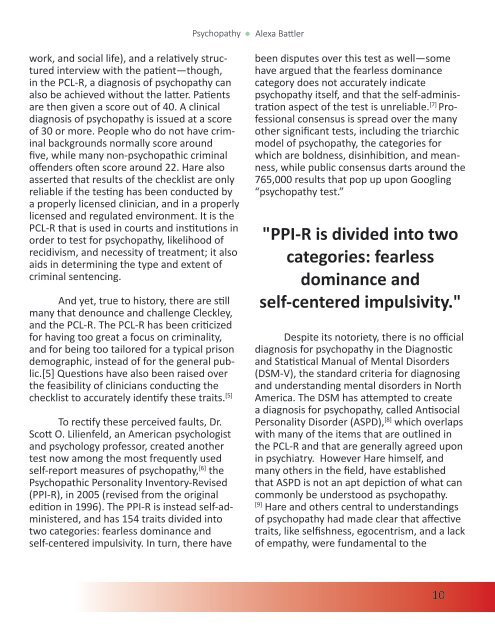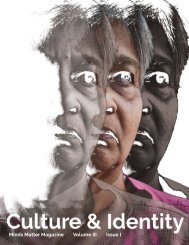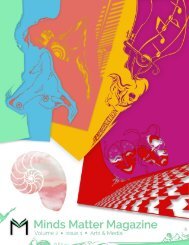E-Issue3_Finallydonep
Create successful ePaper yourself
Turn your PDF publications into a flip-book with our unique Google optimized e-Paper software.
Psychopathy<br />
Alexa Battler<br />
Minds Matter Magazine Volume II Issue I Arts & Media<br />
work, and social life), and a relatively structured<br />
interview with the patient—though,<br />
in the PCL-R, a diagnosis of psychopathy can<br />
also be achieved without the latter. Patients<br />
are then given a score out of 40. A clinical<br />
diagnosis of psychopathy is issued at a score<br />
of 30 or more. People who do not have criminal<br />
backgrounds normally score around<br />
five, while many non-psychopathic criminal<br />
offenders often score around 22. Hare also<br />
asserted that results of the checklist are only<br />
reliable if the testing has been conducted by<br />
a properly licensed clinician, and in a properly<br />
licensed and regulated environment. It is the<br />
PCL-R that is used in courts and institutions in<br />
order to test for psychopathy, likelihood of<br />
recidivism, and necessity of treatment; it also<br />
aids in determining the type and extent of<br />
criminal sentencing.<br />
And yet, true to history, there are still<br />
many that denounce and challenge Cleckley,<br />
and the PCL-R. The PCL-R has been criticized<br />
for having too great a focus on criminality,<br />
and for being too tailored for a typical prison<br />
demographic, instead of for the general public.[5]<br />
Questions have also been raised over<br />
the feasibility of clinicians conducting the<br />
checklist to accurately identify these traits. [5]<br />
To rectify these perceived faults, Dr.<br />
Scott O. Lilienfeld, an American psychologist<br />
and psychology professor, created another<br />
test now among the most frequently used<br />
self-report measures of psychopathy, [6] the<br />
Psychopathic Personality Inventory-Revised<br />
(PPI-R), in 2005 (revised from the original<br />
edition in 1996). The PPI-R is instead self-administered,<br />
and has 154 traits divided into<br />
two categories: fearless dominance and<br />
self-centered impulsivity. In turn, there have<br />
been disputes over this test as well—some<br />
have argued that the fearless dominance<br />
category does not accurately indicate<br />
psychopathy itself, and that the self-administration<br />
aspect of the test is unreliable. [7] Professional<br />
consensus is spread over the many<br />
other significant tests, including the triarchic<br />
model of psychopathy, the categories for<br />
which are boldness, disinhibition, and meanness,<br />
while public consensus darts around the<br />
765,000 results that pop up upon Googling<br />
“psychopathy test.”<br />
"PPI-R is divided into two<br />
categories: fearless<br />
dominance and<br />
self-centered impulsivity."<br />
Despite its notoriety, there is no official<br />
diagnosis for psychopathy in the Diagnostic<br />
and Statistical Manual of Mental Disorders<br />
(DSM-V), the standard criteria for diagnosing<br />
and understanding mental disorders in North<br />
America. The DSM has attempted to create<br />
a diagnosis for psychopathy, called Antisocial<br />
Personality Disorder (ASPD), [8] which overlaps<br />
with many of the items that are outlined in<br />
the PCL-R and that are generally agreed upon<br />
in psychiatry. However Hare himself, and<br />
many others in the field, have established<br />
that ASPD is not an apt depiction of what can<br />
commonly be understood as psychopathy.<br />
[9]<br />
Hare and others central to understandings<br />
of psychopathy had made clear that affective<br />
traits, like selfishness, egocentrism, and a lack<br />
of empathy, were fundamental to the<br />
diagnosis. However in the DSM-III, published<br />
in 1980, ASPD was instead characterized<br />
primarily by the ways in which social norms<br />
were broken, such as lying, stealing, and even<br />
traffic arrests, diminishing these traits that<br />
so many saw as crucial. [9] This definition was<br />
also far too broad to constitute psychopathy<br />
as established by other tests and ideas. While<br />
most that are understood to be psychopaths<br />
meet the criteria for ASPD, most people with<br />
ASPD are not actually psychopaths by this<br />
same popular criteria. [9] As it stands, only one<br />
in five people with ASPD could fit a diagnosis<br />
of psychopathy. [10]<br />
And yet, many believe psychopathy to<br />
be a finalized diagnosis supported by<br />
psychiatric certainty, immediately indicative<br />
of an individual’s character. This perception<br />
has been largely influenced by negative<br />
media portrayals, in which psychopaths are<br />
often cast in villainous roles. While these<br />
depictions may ring a vaguely relative<br />
truth—yes, Hannibal Lecter is a psychopath<br />
according to all of the previously mentioned<br />
tests—they are largely overly dramatic, and<br />
imply traits and behaviours that are not<br />
actually associated with psychopathy.<br />
“At the very least the media should<br />
show both sides of psychopathy, not just<br />
showing them as cold-blooded murderers.<br />
Psychopathy does not mean criminality”<br />
clarified Guillaume Durand, a PhD candidate<br />
in neuroscience at Maastricht University.<br />
“[Media] don’t show that there is actually<br />
very little agree ment on what psychopathy<br />
is.”<br />
In 2013, two Belgian psychiatrists<br />
addressed how movies portrayed so-called<br />
psychopaths. They studied over 400 films<br />
released between 1915, beginning with<br />
Birth of a Nation, and 2010, ending with The<br />
Lovely Bones, all of which included a villain<br />
that was portrayed as a psychopath. [11] The<br />
psychiatrists had to eliminate all but 126 of<br />
these films, because most of the portrayals<br />
were “too caricatured and or too fictional” to<br />
constitute even a vaguely correct reflection<br />
of psychopathy. This in itself is a powerful<br />
reflection of how movies choose to portray<br />
psychopathy. What they identify as the<br />
“Hollywood psychopath” encompasses a<br />
variety of symptoms not typical with<br />
psychopathy, including high intelligence,<br />
fascination with fine arts, obsessive<br />
behaviour, and exceptional capacity for<br />
violence and killing. [11] They also clarified<br />
that most characters largely associated with<br />
psychopathy, like Norman Bates from Psycho,<br />
actually suffer from psychosis, which is a<br />
disconnect with reality, not a personality<br />
disorder. [3] The study praised Anton Chigurh<br />
from No Country for Old Men, Henry from<br />
Henry - Portrait of a Serial Killer and Gordon<br />
Gekko from Wall Street for being more<br />
"Psychosis is a disconnect<br />
with reality, not a<br />
personality disorder."<br />
accurate and insightful views on psychopathy.<br />
[11]<br />
“Usually more representation is always<br />
positive—people always fear what they don’t<br />
know. But [the media] only gives one side”<br />
10 11






